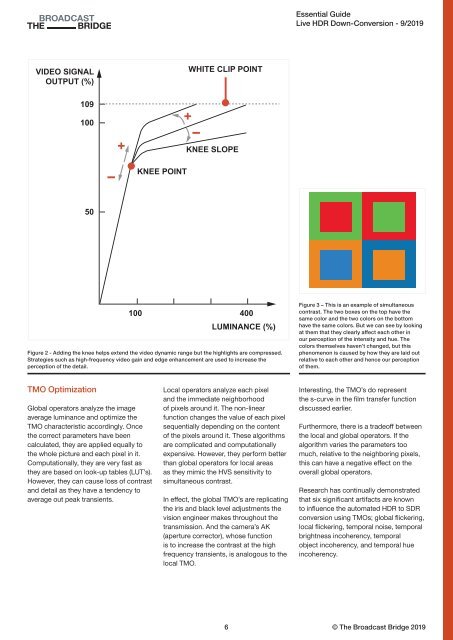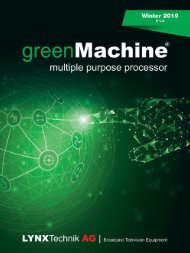ESSENTIAL GUIDE: Live HDR Down-Conversion
Essential Guide published by Broadcast Bridge in cooperation with LYNX-Technik AG discussing the challenges of live HDR-Down-conversion.
Essential Guide published by Broadcast Bridge in cooperation with LYNX-Technik AG discussing the challenges of live HDR-Down-conversion.
Create successful ePaper yourself
Turn your PDF publications into a flip-book with our unique Google optimized e-Paper software.
Essential Guide<br />
<strong>Live</strong> <strong>HDR</strong> <strong>Down</strong>-<strong>Conversion</strong> - 9/2019<br />
VIDEO SIGNAL<br />
OUTPUT (%)<br />
WHITE CLIP POINT<br />
109<br />
100<br />
+<br />
+<br />
KNEE SLOPE<br />
KNEE POINT<br />
50<br />
100 400<br />
LUMINANCE (%)<br />
Figure 2 - Adding the knee helps extend the video dynamic range but the highlights are compressed.<br />
Strategies such as high-frequency video gain and edge enhancement are used to increase the<br />
perception of the detail.<br />
Figure 3 – This is an example of simultaneous<br />
contrast. The two boxes on the top have the<br />
same color and the two colors on the bottom<br />
have the same colors. But we can see by looking<br />
at them that they clearly affect each other in<br />
our perception of the intensity and hue. The<br />
colors themselves haven’t changed, but this<br />
phenomenon is caused by how they are laid out<br />
relative to each other and hence our perception<br />
of them.<br />
TMO Optimization<br />
Global operators analyze the image<br />
average luminance and optimize the<br />
TMO characteristic accordingly. Once<br />
the correct parameters have been<br />
calculated, they are applied equally to<br />
the whole picture and each pixel in it.<br />
Computationally, they are very fast as<br />
they are based on look-up tables (LUT’s).<br />
However, they can cause loss of contrast<br />
and detail as they have a tendency to<br />
average out peak transients.<br />
Local operators analyze each pixel<br />
and the immediate neighborhood<br />
of pixels around it. The non-linear<br />
function changes the value of each pixel<br />
sequentially depending on the content<br />
of the pixels around it. These algorithms<br />
are complicated and computationally<br />
expensive. However, they perform better<br />
than global operators for local areas<br />
as they mimic the HVS sensitivity to<br />
simultaneous contrast.<br />
In effect, the global TMO’s are replicating<br />
the iris and black level adjustments the<br />
vision engineer makes throughout the<br />
transmission. And the camera’s AK<br />
(aperture corrector), whose function<br />
is to increase the contrast at the high<br />
frequency transients, is analogous to the<br />
local TMO.<br />
Interesting, the TMO’s do represent<br />
the s-curve in the film transfer function<br />
discussed earlier.<br />
Furthermore, there is a tradeoff between<br />
the local and global operators. If the<br />
algorithm varies the parameters too<br />
much, relative to the neighboring pixels,<br />
this can have a negative effect on the<br />
overall global operators.<br />
Research has continually demonstrated<br />
that six significant artifacts are known<br />
to influence the automated <strong>HDR</strong> to SDR<br />
conversion using TMOs; global flickering,<br />
local flickering, temporal noise, temporal<br />
brightness incoherency, temporal<br />
object incoherency, and temporal hue<br />
incoherency.<br />
6 © The Broadcast Bridge 2019





